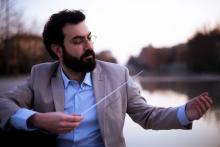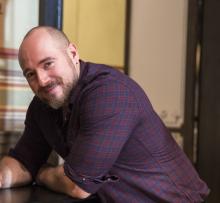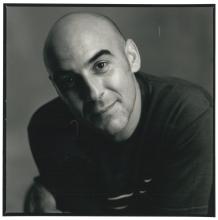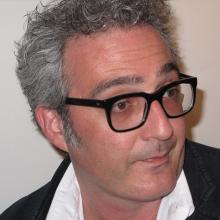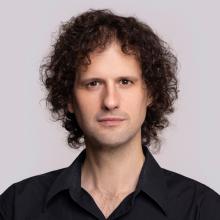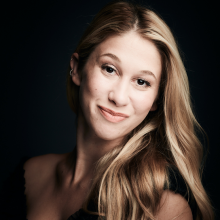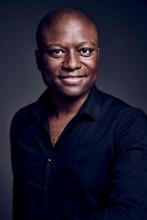Rigoletto

Performance information
Voorstellings-informatie
Performance information
Rigoletto
Giuseppe Verdi
1813-1901
Duration
2 hours and 35 minutes, including an intermission after the first act
This performance is sung in Italian with Dutch and English surtitles.
Opera in drie bedrijven
World Premiere
March 11, 1851
Teatro La Fenice, Venice
Musical direction
Antonino Fogliani
Marco Alibrando (18 & 20 September)
Stage direction
Damiano Michieletto
Set design
Paolo Fantin
Costume design
Agostino Cavalca
Lighting design
Alessandro Carletti
Video
Roland Horvath
Staging
Marcin Łakomicki
Il Duca di Mantova
René Barbera
Rigoletto
Roman Burdenko
Gilda
Aigul Khismatullina
Sparafucile
Alexander Köpeczi
Maddalena
Maya Gour
Giovanna
Eva Kroon
Il Conte di Monterone
Frederik Bergman
Marullo
Martin Mkhize
Borsa
Salvador Villanueva*
Il Conte di Ceprano
Joe Chalmers*
La Contessa di Ceprano
Martina Myskohlid*
Paggio della Duchessa
Daria Brusova*
Usciere di corte
Peter Arink**
* Dutch National Opera Studio
** Chorus of Dutch National Opera
Netherlands Philharmonic
Chorus of Dutch National Opera
Chorus master
Edward Ananian-Cooper
Production team
Assistant conductor
Marco Alibrando
Assistant director
Meisje Barbara Hummel
Directing intern
Wieger Meulenbroek (as part of a talent development project at Oorkaan)
Rehearsal pianists
Fabio Cerroni
Irina Sisoyeva
Daniel Ruiz de Cenzano Caballero
Language coach
Fabio Cerroni
Assistant chorus master
Ad Broeksteeg
Language coach chorus
Valentina di Taranto
Stage managers
Marie-José Litjens
Roland Lammers van Toorenburg
Lucia van der Pasch
Artistic planning
Emma Becker
Orchestra inspector
Pauline de Bruijn
Assistant costume designer
Chiara Almatea Ciarelli
Costume supervisor
Lars Willhausen
Master carpenter
Jeroen Jaspers
Lighting manager
Cor van den Brink
Senior props manager
Jolanda Borjeson
Props manager
Quani Wolters
Senior dresser
Jenny Henger
Senior make-up artist
Pim van der Wielen
Sound engineer
Leonardo Santos
Dramaturgy
Laura Roling
Surtitles director
Eveline Karssen
Surtitles operator
Irina Trajkovska
Senior music librarian
Rudolf Weges
Production supervisor
Mark van Trigt
Production manager
Joshua de Kuyper
Chorus of Dutch National Opera
Tenors
Gabriele Bonfanti
Frank Engel
Cato Fordham
Livio Gabrielli
Dimo Georgiev
John van Halteren
Stefan Kennedy
Robert Kops
Tigran Matinyan
Frank Nieuwenkamp
Richard Prada
François Soons
Jeroen de Vaal
Bert Visser
Rudi de Vries
Basses
Ronald Aijtink
Peter Arink
Nicolas Clemens
Emmanuel Franco
Hans Pieter Herman
Fabian Homburg
Geert van der Kaaij
Dominic Kraemer
Maksym Nazarenko
Christiaan Peters
Jamie Rock
Matthijs Schelvis
Jaap Sletterink
René Steur
Harry Teeuwen
Extras
Extras
Ignacio Sanz Fernandez
Alexey Shkolnik
Children
Olivia Chance
Rosa Warnink
Children's supervisor
Anja ten Klooster
Netherlands Philharmonic
First Violin
Vadim Tsibulevsky
Saskia Viersen
Koen Stapert
Juho Valtonen
Valentina Bernardone
Mascha van Sloten
Derk Lottman
Tessa Badenhoop
Marieke Kosters
Novile Maceinaite
Ilja Venema
Marina Malkin
Henrik Svahnström
Paul Reijn
Hike Graafland
Second Violin
David Peralta Alegre
Mintje van Lier
Ana Nedobora Ivanova
Eva de Vries
Jeanine van Amsterdam
Elisa Dijkstra
Charlotte Basalo Vázquez
Lilit Poghosyan Grigoryants
Wiesje Nuiver
Bernardo Sousa
Karina Korevaar
Anita Jongerman
Jarmila Delaporte
Viola
Laura van der Stoep
Asdis Valdimarsdottir
Marjolein de Waart
Suzanne Dijkstra
Stephanie Steiner
Anna Smith
Odile Torenbeek
Arwen Salama-van der Burg
Avi Malkin
Merel van Schie
Cello
Joachim Müller-Crepon
Douw Fonda
Rik Otto
Carin Nelson
Liesbeth Bosboom
Atie Aarts
Anjali Tanna
Nil Domènech Fuertes
Double Bass
Mario Torres Valdivieso
Gabriel Abad Varela
Julien Beijer
Peter Rikkers
Joe Prindl
Marí Ángeles Ruiz Bolancé
Flute
Hanspeter Spannring
Piccolo and Flute
Ellen Vergunst
Oboe
Toon Durville
Oboe and English Horn
Maxime le Minter
Clarinet
Rick Huls
Peter Cranen
E-flat Clarinet Banda Interna
Annemiek de Bruin
Bassoon
Remko Edelaar
Susan Brinkhof
Horn
Wouter Brouwer
Stef Jongbloed
Miek Laforce
Fred Molenaar
Trumpet
Ad Welleman
Marc Speetjens
Trombone
Bram Peeters
Harrie de Lange
Joao Mendes Canelas
Cimbasso
David Kutz
Timpani
Theun van Nieuwburg
Percussion
Diego Jaén García
Matthijs van Driel
Nando Russo

In a nutshell
About Giuseppe Verdi, Victor Hugo, and the music of Rigoletto.
In a nutshell
Giuseppe Verdi
Giuseppe Verdi (1813-1901) is one of the greatest Italian composers in the history of opera. His international breakthrough came in 1842 with the opera Nabucco. This was followed by a productive period that resulted in the three operatic hits of Rigoletto (1851), Il trovatore (1853), and La traviata (1853). Verdi continued composing operas into old age, producing Otello in 1887 and his swansong Falstaff in 1893. Verdi’s work stands out for his unerring understanding of drama. Verdi mastered Italian opera’s formal conventions and then proceeded to push those boundaries or sometimes even abandon them altogether, all in the interests of enhancing the drama and theatrical impact.
Based on a Victor Hugo play
When La Fenice Opera House in Venice commissioned Giuseppe Verdi to compose an opera for March 1851, Verdi soon decided he wanted to adapt Le roi s’amuse (‘The King Amuses Himself’), a play by the French author Victor Hugo. “The subject matter is grand, fantastic and includes a character who is one of the greatest creations that the theatre of any time and any country can boast of,” wrote Verdi to his librettist Francesco Maria Piave. Victor Hugo’s play was seen as highly audacious and was banned in 1832 after only one performance. Verdi too had a fight with the censors in Venice before he got permission for the opera to be performed.

The music in Rigoletto
Rigoletto is full of sharp contrasts. From the start of the opera, the foreboding musical theme of the ‘curse’ is juxtaposed with the carefree, trivial sounds of the Duke of Mantua and his court. Verdi also plays cleverly with the conventions of Italian opera to define his characters. While the Duke of Mantua sings conventional numbers, including the deliberately banal earworm ‘La donna è mobile’, Rigoletto’s music is much more free-ranging. Rigoletto’s form is the arioso — more melodic than a recitative but less formal than an aria. Musically, it is Rigoletto’s daughter Gilda who experiences the biggest change: her dreamy, flexible coloraturas (ornamentation) gradually make way for a more dramatic vocal line.
A broken father’s flashbacks
When Rigoletto’s daughter Gilda dies at the end of the opera, he loses the only thing that gave his lonely life meaning. The director Damiano Michieletto, who previously directed Rossini’s Il viaggio a Reims (2015) and Alexander Raskatov’s Animal Farm (2023) for Dutch National Opera, believes Rigoletto would inevitably go insane after such a loss. Michieletto uses this insight as the starting point for his production: from the opening bars, Rigoletto is seen locked up in an institution, where he relives the events of the opera in a series of flashbacks. For Michieletto, Rigoletto is first and foremost a tragedy about an obsessive father, and his stage direction highlights Rigoletto’s suffocating relationship with his daughter Gilda.


The story
The jester Rigoletto is one of the most hated people in the court of the Duke of Mantua. He mocks the husbands and fathers of the women seduced by the Duke. But what no one knows is that Rigoletto himself has a daughter, Gilda.
The story
The jester Rigoletto is one of the most hated people in the court of the Duke of Mantua. He mocks the husbands and fathers of the women seduced by the Duke. But what no one knows is that Rigoletto himself has a daughter, Gilda.
Act I
Count Monterone demands satisfaction from the Duke for dishonouring his daughter. Rigoletto ridicules the Count in public. Monterone feels deeply insulted and curses both the Duke and Rigoletto.
Rigoletto only lets his daughter Gilda out of the house to go to church, but now she has fallen in love with another churchgoer. The object of her affections is the Duke, but when he visits her in secret, he tells her he is a poor student called Gualtier Maldé.
A group of courtiers tell Rigoletto they plan to abduct Countess Ceprano, and he promises to help them. He discovers too late that he himself is the victim of a cruel prank, for the abducted woman is none other than Gilda.
Act II
The courtiers tell the Duke what they did the night before. The Duke is surprised and pleased to hear Gilda is now available for him in his palace and he visits her in his bedroom.
Rigoletto enters the palace, overcome by fear and anger. He begs the courtiers to hand over his daughter, but they merely laugh at him. Eventually, Gilda appears, frightened and half-naked. She confesses everything to her father. Rigoletto swears revenge.
Act III
Rigoletto and Gilda are standing outside an inn belonging to the hired assassin Sparafucile and his sister Maddalena. They hear the Duke inside, serenading Maddalena. Rigoletto orders his daughter to flee to Verona disguised as a man.
After Gilda has left, Rigoletto makes a deal with Sparafucile: the assassin will kill the Duke in return for twenty scudi. Rigoletto can pick up the corpse later that night.
Maddalena persuades her brother to change his plan: if someone other than the Duke turns up before midnight, Sparafucile will kill that person rather than the Duke. Gilda, who has returned, overhears this and decides to knock on the door. She is stabbed and hastily pushed into a sack.
Rigoletto arrives and is handed the sack with the body. Then to his astonishment, he hears the supposedly dead Duke singing; he opens the sack and discovers his daughter Gilda. She dies, and Rigoletto remains behind, broken-hearted. Monterone’s curse has been fulfilled.. Monterone’s vloek is vervuld.

On the inception of Verdi’s opera
Verdi had several run-ins with the censors in the course of his career. Rigoletto was no exception, and he faced a challenge getting it accepted.
‘A hunchback who sings? Why not!’
On the inception of Verdi’s opera
Verdi had several run-ins with the censors in the course of his career. Rigoletto was no exception, and he faced a challenge getting it accepted.
Na de succesvolle premières van Ernani (1844) en Attila (1846) in Venetië, kreeg Giuseppe Verdi de vraag om opnieuw een opera voor het Venetiaanse Teatro La Fenice te componeren. De politieke context waarin deze derde opera voor La Fenice tot stand moest komen, was echter bijzonder gevoelig.
After the successful premieres in Venice of Ernani (1844) and Atilla (1846), Giuseppe Verdi was invited to compose another opera for Venice’s Teatro la Fenice. However, by the time Verdi started on this third opera for La Fenice, the political context had become extremely sensitive.
Tighter censorship
In the revolutionary year of 1848, the Venetians drove out their Austrian rulers and declared independence as a republic. However the Austrians were able to reconquer the city in 1849 after a long, exhausting siege, putting Venice once again within the orbit of the Habsburg Empire. Re-establishing control over the Venetians was a high priority for the Habsburg authorities. Among other things, that meant tightening up censorship. Accordingly, Verdi’s latest opera, scheduled to premiere in spring 1851, was subject to particularly intense scrutiny by the Austrian authorities.
Risky source material
Verdi did not make it easy for himself when he decided to base his new opera on Le roi s’amuse by the French author Victor Hugo. Hugo’s play had premiered in Paris on 22 November 1832, but the planned series of performances was suspended the next day on the order of the authorities, and the play was banned. This decision was probably prompted in part by a failed assassination attempt on the French king Louis-Philippe three days before the premiere. The king in Le roi s’amuse is portrayed as such a reprehensible character, who behaves so appallingly, that the play was considered political dynamite. It was also deemed ‘immoral’, a judgement Hugo himself criticised roundly in his foreword to the publication of Le roi s’amuse (which can be found elsewhere in this programme).

Francesco Maria Piave
When deciding to turn Le roi s’amuse into an opera, Verdi realised he would face a challenge. Despite this, he was prepared to take the risk. On 28 April 1850, he wrote a letter to Francesco Maria Piave, the Venetian librettist with whom he had an excellent working relationship and who was also to write the libretto for this new opera: “The subject matter is grand, fantastic and includes a character who is one of the greatest creations that the theatre of any time and any country can boast of. The subject is Le roi s’amuse and the character I am referring to is Tribolet.” Verdi added a postscript urging his librettist not only to work on the libretto but also to lose no time in ensuring the necessary permission from the authorities. “Get going as soon as you receive this letter. Trawl the whole city to find an influential person who can arrange for permission to use Le roi s’amuse. Don’t slacken; get moving. Be quick about it.”
Absolute prohibition
In the autumn of 1850, the libretto of La maledizione (the initial working title for the opera) had to be sent to the Austrian Department of Public Order for examination. The verdict was merciless: “His Excellency the Military Governor Cavalier de Gorzkowski deplores the fact that the poet Piave and the great maestro Verdi have elected to display their talents in the disgusting immorality and obscene triviality of the plot of the libretto entitled La Maledizione [...]. His aforementioned Excellency therefore deems it necessary to order an absolute prohibition of its performance.”
Unacceptable alterations
The aspects that offended the authorities were not only the ‘immoral’ characters of the libertine aristocrat and his deformed jester but elements such as the sack in which the jester receives his daughter’s body. Verdi was furious. “I don’t understand why the sack has to go! What do the police care about a sack? [...] Without that sack, it’s hardly likely Triboletto would spend half an hour addressing the corpse before a flash of lightning reveals it’s his daughter,” he wrote to La Fenice manager Carlo Marzari on 14 December 1850. Then he added, “Finally, I note they don’t want Triboletto to be ugly and a hunchback!! A hunchback who sings? Why not?!... Will it work? I don’t know, but if even I don’t know then surely the person who proposed this change won’t know either. I actually like the idea of putting this character on stage who is so deformed and ridiculous yet so passionate inside and full of love. I chose this subject matter precisely because of all these qualities and original features, and if they are removed, I won’t be able to compose the music for it anymore.”

Breakthrough
Caught between the censors and a composer who refused to budge, Marzari did everything he could to save the opera. After repeated urgent calls on the Austrian Department of Public Order, he managed to obtain a significant promise from them: they would allow the Duke (not a king!) to remain an absolute ruler and libertine as long as the time and place of the action were changed. They would also allow the jester to remain deformed and dying Gilda to be handed over in a sack. That was a major breakthrough, even if the librettist Piave still had to visit the department in person several times to discuss the final details of the libretto. Finally, on 26 January 1851, he had good news: “Te Deum laudamus! Gloria in excelsis Deo! Alleluja, Alleluja! Yesterday, at three o’clock in the afternoon, our Rigoletto was safely returned to the opera house managers without any broken bones or amputations,” he wrote to Verdi.
The premiere
The preparations could now start for the premiere some six weeks later, on 11 March 1851. Everything went smoothly. Verdi was very pleased with the cast, especially the baritone Felice Varesi as Rigoletto. Varesi had previously given the first interpretation of title role in the world premiere of Verdi’s Macbeth (1847) and he would also be the first person to sing Giorgio Germont in La traviata (1853).
Reception
At its world premiere, Rigoletto received a very warm reception from the audience, although the press response was more mixed. The critic of the Gazzetta Uffiziale di Venezia objected to the opera on moral grounds: “The composer and the poet aim to create an effect, not through the usual channels of pity and fear, but through the torture of the soul and destruction. We cannot with a good conscience applaud such taste. Nevertheless, the opera was a resounding success and the composer was praised and cheered after nearly every number, and two numbers even had to be sung again.” This critic was not alone in his assessment. At the premiere in London in 1853, the opera was not only labelled “dull, dismal and weak” but also described as “puerile and ridiculous, full of vulgarity and eccentricity and barren of ideas”.

Unauthorised versions
It is telling that in the decade after the premiere, Rigoletto was frequently performed in much altered unauthorised versions, with titles such as Viscardello, Lionello and Clara di Perth. The alterations are sometimes rather strange. For example, in Viscardello, which is set in sixteenth-century England, the version’s equivalent of Monterone issues a ‘friendly warning’ rather than a curse. In the final act, rather than being handed over in a sack, Gilda’s body is covered by a cloak. She turns out merely to have a minor wound on her arm and the opera ends (without any changes to Verdi’s music!) with the relieved reunion of father and daughter.
At the limit
Verdi’s fight with the censors before the premiere, the reactions in the press and the fact that the unauthorised versions made such fundamental changes to the opera all show that Rigoletto was an opera at the limit of what was deemed acceptable, not only musically but also in terms of its characters and action. In an opera world where the leading roles were reserved for gods and aristocrats and where a clear distinction was usually made between ‘good’ and ‘evil’, Verdi and Piave had introduced an ambiguous protagonist low down the social hierarchy, marked by a physical deformation and who, moreover, is exceptionally cruel. Yet he is the character we are most able to empathise with. Modern-day performers and directors now have the task of exhibiting the same boldness and bravery in their productions of Rigoletto to give it the same edginess the opera had in 1851.
Dutch text: Laura Roling
English translation: Clare Wilkinson

Director Damiano Michieletto on Rigoletto
In his stage direction, Damiano Michieletto has chosen to present the opera’s events as flashbacks in the mind of a deranged and broken man. Michieletto explains to us why he decided on this approach to Verdi’s classic.
The tragedy of an obsessive father
Director Damiano Michieletto on Rigoletto
In his stage direction, Damiano Michieletto has chosen to present the opera’s events as flashbacks in the mind of a deranged and broken man. Michieletto explains to us why he decided on this approach to Verdi’s classic.
“There are various elements you can emphasize when directing Rigoletto, and I have chosen the curse as the driving force. Throughout the opera, the audience are constantly reminded of the curse Monterone casts upon Rigoletto in the first act. Indeed, it’s no coincidence that Verdi and his librettist Francesco Maria Piave initially considered calling the opera La maledizione (The Curse). The curse results in Rigoletto discovering that he himself was responsible for the death of his beloved daughter Gilda.”
Madness
“I asked myself how someone in Rigoletto’s position would react to such an immense tragedy. You need to realize that Rigoletto is not just some ordinary person; he is an intensely lonely individual. He has no friends or family other than Gilda, and he has an unhealthy fixation on his daughter. Knowing that he caused her death makes it impossible for him to go back to his old life again. He is repulsed not only by the Duke but also by his own role as jester at the court. Given this, his madness seems inevitable.”
Guilty feeling
“In my production, the setting is one in which the events in the opera are experienced as flashbacks from Rigoletto’s point of view. Like the obsessive madman he is, in his mind he replays the tragedy for which he feels responsible. He is crushed by his feelings of guilt and has lost all contact with reality. He may still be breathing, but it is as if he has ceased living. He is a mere shadow of his former self. In addition to his recall of the events in the opera, I have added flashbacks to Gilda’s early childhood to highlight the intimate relationship between father and daughter and accentuate the painfulness of the memories.”

“The set designer Paolo Fantin and I decided to locate the action in the room where Rigoletto has been confined after going insane. The set is not just a sterile, clinical white space but also a mental space that lets us get inside Rigoletto’s mind and see what happened from his perspective.”
Father and daughter
“I tried to avoid clichés associated with Rigoletto’s role as court jester. Instead, I’ve focused on his deep sense of misery. He feels constricted by his relationship with the Duke, who laughs at everything and sees it all as a game. So it’s the Duke’s laugh that follows Rigoletto everywhere. Rigoletto fastens his hope on Gilda as the only antidote to the misery of his daily life. That’s why he keeps her secluded and protects her from the outside world. But Gilda is desperate for freedom and independence. She is in love and wants to experience life. She finds her relationship with her father suffocating because of the pathological, obsessive side to it. However, her protective upbringing has made her naive and she doesn’t realize the Duke is a playboy who is merely using her.”
The Duke of Mantua
“I see a lot of similarities between the womanizer Don Giovanni in Mozart’s opera and the Duke of Mantua. Both are powerful men who have no scruples about abusing their position. Everything they do is geared towards fulfilling their sexual desires. As with Don Giovanni, it doesn’t really matter to the Duke whether the woman in question is Gilda, Maddalena or the Countess of Ceprano. He is not interested in politics or administrative matters. All he does is party, from the start of the opera to the end.”

“However, my stage direction doesn’t focus on the Duke’s sexual morals. What I want to stress is how Rigoletto becomes obsessed with him. The chorus singers wear masks with the Duke’s face, showing how Rigoletto can’t get the Duke and his eternal laughter out of his head.”
Monterone
“The Count of Monterone is also a key character in that respect. When his daughter is dishonoured by the Duke, he takes his complaint to the court. He has several important similarities to Rigoletto. Like Rigoletto later in the opera, Monterone is distraught and in tears as he demands justice. Significantly, it is Rigoletto who ridicules him just when he is so vulnerable. It is almost as if Rigoletto is not only mocking Monterone but also himself. That’s why, in my production, Monterone takes on Rigoletto’s physical appearance when he comes on stage.”
Shakespeare
We know that Verdi was a great fan of William Shakespeare’s plays, and that is reflected in Rigoletto. The opera is based on Victor Hugo’s intense historical drama Le roi s’amuse, whose action and setting are reminiscent of Shakespeare. Rigoletto in particular is a Shakespearean character who has similarities with King Lear. Lear and Rigoletto are both fathers who wants above all else to be loved by their daughters but who create misery for both their daughters and themselves through their own actions. Shakespeare’s play has a famous scene with a thunderstorm in which Lear turns mad and ends up holding the corpse of his beloved daughter Cordelia in his arms. Rigoletto too ends up a mentally broken man after a storm, with the lifeless body of his daughter Gilda.”

Revenge
“From the moment he finds out the Duke has dishonoured his daughter, Rigoletto devotes his life to wreaking revenge. ‘Vendetta, tremenda vendetta,’ we hear him call doggedly at the close of the second act. His instincts are almost animal-like. However, I would like to stress once again that I’ve deliberately stayed away from the long tradition of Rigoletto as a jester, clown and hunchback. I wanted to focus instead on Rigoletto as a father. So I asked myself various questions, such as: Who was Gilda’s mother? What was Gilda’s childhood like without a mother and with such an obsessive father? Even more importantly, what is driving Gilda’s absurd longing for freedom? Gilda sacrifices her own life to save the Duke, despite knowing the man doesn’t love her and has betrayed her.”
“The opera doesn’t give many clues to the answers to these questions so I have come up with my own answers from a broader perspective. I think Gilda prefers to die rather than continue to live under the restrictive dominion of her father. The way I imagine it, after Gilda is ordered by her father to disguise herself in men’s clothes and flee to Verona, she sets off home and all of a sudden stops, breathes a sigh of relief and says, ‘No, this time I’m not going to listen to my father; I’m going to do my own thing.’ She doesn’t yet know what will happen to her but she does know she needs to break this unhealthy bond with her father, whatever the cost. When she discovers the Duke is about to be murdered, she decides to offer up her own life. It is an act of desperation, committed not just from love for the Duke but as much, if not more so, to escape the clutches of her father.”
Text: Leonardo Mello (2021)
Dutch translation: Laura Roling

On the music in Verdi’s Rigoletto
The power of Verdi’s work lies in his unerring sense of theatre. Nowhere is that more evident than in Rigoletto, where the composer achieves a big impact by breaking with the conventions of Italian opera that reigned in his day. A musical tour of the opera.
A musical and dramatic tour de force
On the music in Verdi’s Rigoletto
The power of Verdi’s work lies in his unerring sense of theatre. Nowhere is that more evident than in Rigoletto, where the composer achieves a big impact by breaking with the conventions of Italian opera that reigned in his day. A musical tour of the opera.
Italian opera in the first half of the nineteenth century was highly stylised. The drama was usually expressed using certain ‘closed forms’ that were familiar to the audiences. The most striking of these was the multipartite aria (a solo aria in several parts). It started with a cantabile or adagio (usually slow and lyrical, giving the singer an opportunity to demonstrate their ability to maintain an attractive vocal line) and — after a discretionary intervening movement — a cabaletta (faster and more powerful, allowing the singer to show off their agility). The custom was for all the main characters to be introduced with such multipartite arias; this meant that the first act of an opera was often little more than a series of showpieces. Then there was the inevitable concertato finale, traditionally performed halfway through the drama. This large-scale form brings the chorus and main characters together, sometimes in a rather contrived fashion in terms of the drama.
Rigoletto may now be seen as a classic example of Italian opera, but when it premiered it was considered a highly innovative work. For example, Verdi did not stick rigorously to the conventions described above. There is no concertato finale and the title character, Rigoletto, does not have any multipartite arias. In fact, he does not have any conventional arias at all. For Verdi, the drama, characters and their development were the driving forces in Rigoletto, from the opening bars to the final notes.
An opening rich in contrasts
From that perspective, it is noticeable how Verdi incorporates extreme contrasts in his composition from the start. Before the curtain rises, the opening bars of the Prelude contain the foreboding theme of the ‘curse’, which builds up to a climatic outburst. But then the curtain rises to reveal a cheerful banda, a small orchestra on stage playing dance tunes. It creates a festive atmosphere, but at a deeper level the vacuity of the music suggests a ducal court consumed with the unthinking pursuit of pleasure.
After a short conversation between the Duke and one of his courtiers, the dance sequence is interrupted by the Duke’s first aria, ‘Questa o quella’ (This woman or that one). The swinging rhythm, the strophic form and the straightforward orchestration are perfect for presenting the Duke’s superficial, cynical attitude to love.
Monterone’s ominous entry receives an answer in Rigoletto’s biting monologue, full of sections with the strings in unison or playing trills, and with the brass and strings sounding mocking laughter. The curse Monterone utters in response is underlined by a rhythm repeated emphatically by the orchestra.
Rigoletto’s first arioso
After Rigoletto has left the party, we hear a restrained reminder of the curse theme. The dialogue that follows between Rigoletto and Sparafucile, a hired assassin, is supported by an orchestral melody for a muted solo cello and double bass. The tension between this dark sonorousness and the carefree, lyrical melody emphasises the contrast between the business-like dialogue and the sinister subject matter. The duet is followed by Rigoletto’s famous 'Pari siamo' (We are the same), the first of the main character’s lengthy ariosi. The arioso – best defined as a mix of recitative and aria with the flexibility of the former and the emotional power of the latter — is Rigoletto’s most characteristic musical form, precisely because it offers the necessary freedom and intensity. This arioso presents the contrasting sides of Rigoletto’s character: when his bitter taunts about court life make way for tender thoughts of his daughter Gilda, a completely new lyricism appears in the vocal score.

The full orchestra then comes in suddenly to introduce Gilda in the first of three long duets (one per act) for father and daughter. The first part contrasts the lyrical, ‘paternal’ vocal line of the jester with Gilda’s breathless, ‘sobbing’ line. The second part is interrupted when Rigoletto rushes off to investigate a sound off-stage (the Duke is making his secret entrance). When Rigoletto returns, the musical contrast between the two characters is even greater, with ornamentation and exuberant figures used to stress Gilda’s youthful charms.
Caro nome
Gilda’s only aria in Rigoletto, the famous ‘Caro nome’ (Cherished name), reinforces our impression of her nature. The two flutes, the violin motif that punctuates each vocal phrase and the subtle harmony of the coda all help create the delicate musical backdrop against which Gilda’s dreamy thoughts take wing. What is more, the opening and close of ‘Caro nome’ are good examples of how at this stage in his career Verdi begins blending scenes together. At the start, the music accompanying Gilda’s contemplation of her beloved’s name is a subtle key change from the previous number, while at the end the courtiers come in before Gilda has finished.
Gilda’s character undergoes a clear development in the course of the tragedy. In the second act, when she tells her father what has happened, she is accompanied by a solo oboe rather than flutes. In addition, she sings in staccato rhythms, with far less ornamentation than in the first act.
The Duke: a character with no development
It is apt that the Duke’s three important solo arias are all unconnected to the emotional core of the drama. There is no development in his character between the ‘Questa o quella’ of the first act and his ‘La donna è mobile’ (Women are fickle) of the third act. There is a hint of more depth only briefly in his scena ed aria at the start of the second act. This is mainly due to the expressiveness of the lyrical first part ‘Parmi veder le lagrime’ (It is as if I see tears) with its rhythmically flexible, expansive melodic line. But when the Duke’s train of thought is interrupted by the arrival of the courtiers, he soon recollects himself and hurries lecherously off to the bedroom after a cabaletta ‘Possente amor mi chiama’ (I am called by powerful love), which incidentally is sometimes cut from performances.
Rigoletto’s tour de force
After the Duke has joined Gilda, Rigoletto enters and sings what is his most impressive arioso of the whole opera. At first, he tries to maintain his pose as the court jester with the forced cheerfulness of his ‘La rà, la rà’. When the Page intervenes and Rigoletto realises the Duke is with Gilda, his growing anger is expressed by the feverish music of the strings. ‘Cortigiani, vil razza dannata’ (Courtiers, accursed race of cowards) consists of three parts, each in a different key. Each part marks a change in Rigoletto’s mood. In the first part, Rigoletto’s angry declamation is stifled by his tears, with tight, almost obsessive accompaniment by the string section. The string accompaniment is looser in the second part and the vocal line is much closer to the natural rhythm of speech. In the third part, ‘Miei signori’ (Gentlemen), the understated musical accompaniment of the orchestra allows the high baritone to achieve a moment of great lyrical intensity.

The quartet
In terms of the musical drama, the quartet in the third act is one of the opera’s high points. The characters converse freely over a rhythmically complex violin melody; the orchestration is delicate, with a pizzicato bass line and first violins that move effortlessly around the vocal line. The main section of the quartet, ‘Bella figlia dell’amore’ (Beautiful daughter of love) is striking for how the four soloists maintain their individual musical identities from start to finish. The Duke’s passionate love song serves as the starting point for the other three characters: Maddalena responds with idiosyncratic babble, Gilda with short phrases that sometimes soar lyrically above the rest, while Rigoletto’s obsession with revenge holds him firmly rooted in the bass line.
Formal liberties
The opera’s final numbers — the Scena, Terzetto e Tempesta, followed by the last duet — are hard to classify within the conventions of nineteenth-century opera. While the first number has a trio at its heart, the surrounding mix of recitatives, the tempest sounds and reminiscences of the quartet and ‘La donna è mobile’ give the music a formal freedom that is unparalleled in Italian operas from this period. The music expressing the growing storm, which comes to a terrifying climax as Gilda is stabbed, eventually makes way for an ominous silence. This context only adds to the impact of the Duke’s sleepy reprise of ‘La donna è mobile’.
The final duet between Rigoletto and Gilda offers a much-needed point of stability in a hectic closing sequence. It is also an opportunity to refer indirectly to preceding musical numbers. For example, the solo flute’s arpeggios in ‘Lassù in ciel’ (Above in heaven) inevitably recall the ‘Caro nome’ of an as-yet innocent Gilda and remind the audience of the development Gilda has gone through. Rigoletto’s final, tortured recollection of the curse is confirmation that the musical and dramatic action have reached their end.
Text: based on Roger Parker
Reworking and Dutch translation: Laura Roling

